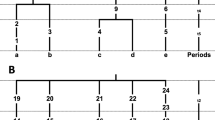Abstract
The dependence of the rate of neutral molecular evolution on both biological parameters and demographic population factors has been investigated. Real genetic data and an individual-based model of the population dynamics were used for the study. The first part of the study deals with tracing the neutral molecular evolution occurring in the model concurrently with adaptive speciation. The second part concerns the effect of individual biological parameters and demographic population factors of members of the Order Testudines (Turtles) on the relative rate of evolution of the mitochondrial CytB gene. It has been shown that demographic population factors and individual biological parameters affect the rate of the neutral molecular evolution.
Similar content being viewed by others
References
Zuckerkandl, E. and Pauling, L., Molecules as Documents of Evolutionary History, J. Theor. Biol., 1965, vol. 8, pp. 357–366.
Kimura, M., The Neutral Theory of Molecular Evolution, Cambridge Univ. Press, 1983.
Barraclough, T.G. and Nee, S., Phylogenetics and Speciation, Trends Ecol. Evol., 2001, vol. 16, pp. 391–399.
Emerson, B.C., Paradis, E., and Thebaud, C., Revealing the Demographic Histories of Species Using DNA Sequences, Trends Ecol. Evol., 2001, vol. 16, pp. 707–716.
Martin, A.P. and Palumbi, R.S., Body Size, Metabolic Rate, Generation Time, and Molecular Clock, Proc. Natl. Acad. Sci. USA, 1993, vol. 90, pp. 4087–4091.
Martin, A.P. and Palumbi, S.R., Protein Evolution in Different Cellular Environments: Cytochrome B in Sharks and Mammals, Mol. Biol. Evol., 1993, vol. 10, pp. 873–891.
Adachi, J. and Hasegawa, M., Tempo and Mode of Synonymous Substitutions in Mitochondrial DNA of Primates, Mol. Biol. Evol., 1996, vol. 13, pp. 200–208.
Castro, L.R., Austin, A.D., and Dowton, M., Contrasting Rates of Mitochondrial Molecular Evolution in Parasitic Diptera and Hymenoptera, Mol. Biol. Evol., 2002, vol. 19, pp. 1100–1113.
Bromham, L., Molecular Clocks in Reptiles: Life History Influences Rate of Molecular Evolution, Mol. Biol. Evol., 2002, vol. 19, pp. 302–309.
Britten, R.J., Rates of DNA Sequence Evolution Differ Between Taxonomic Groups, Science, 1986, vol. 231, pp. 1393–1398.
Kohne, D.E., Evolution of Higher Organism DNA, Quart. Rev. Biophys., 1970, vol. 3, pp. 327–375.
Ohta, T., Population Size and Rate of Evolution, J. Mol. Evol., 1972, vol. 1, pp. 305–314.
Semovski, S.V., Bukin, Yu.S., and Sherbakov, D.Yu., Speciation and Neutral Molecular Evolution in One-Dimensional Closed Population, Int. J. Modern Physics. C, 2003, vol. 14, pp. 973–984.
Semovski, S.V., Verheyen, E., and Sherbakov, D.Yu., Simulating the Evolution of Neutrally Evolving Sequences in a Population under Environmental Changes, Ecol. Model., 2004, vol. 176, pp. 99–107.
Dieckmann, U. and Doebelli, M., On the Origin of Species by Sympatric Speciation, Nature, 1999, vol. 400, pp. 354–357.
Takimoto, G., Higashi, M., and Yamamura, N.A., Deterministic Genetic Model for Sympatric Speciation by Sexual Selection, Evolution, 2000, vol. 54, pp. 1870–1881.
Takezaki, N., Rzhetsky, A., and Nei, M., Phylogenetic Test of the Molecular Clock and Linearized Trees, Mol. Biol. Evol., 1995, vol. 12, pp. 823–833.
Doebeli, M. and Dieckmann, U., Speciation Along Environmental Gradients, Nature, 2003, vol. 421, pp. 259–264.
Penna, T.J.P., A Very Simple Model of Biological Aging, J. Stat. Phys., 1995, vol. 78, pp. 1629–1631.
Gavrilets, S., Li, H., and Vose, M.D., Patterns of Parapatric Speciation, Evolution, 2000, vol. 54, pp. 1126–1134.
Author information
Authors and Affiliations
Corresponding author
Additional information
Original Russian Text © V.P. Fazalova, S.V. Semovski, D.Yu. Sherbakov, G. Meunier, 2007, published in Genetika, 2007, Vol. 43, No. 9, pp. 1172–1180.
Rights and permissions
About this article
Cite this article
Fazalova, V., Semovski, S.V., Sherbakov, D.Y. et al. The effect of demographic population factors and individual biological parameters on the rate of the neutral molecular evolution. Russ J Genet 43, 973–980 (2007). https://doi.org/10.1134/S1022795407090025
Received:
Issue Date:
DOI: https://doi.org/10.1134/S1022795407090025




